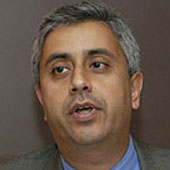Verdict on Greenspan: Guilty, But Not as Charged
As Fed Chairman, Greenspan utterly failed to limit leverage and bubbles, and this failure magnified financial fragility.
October 24, 2016
The conventional wisdom about former Fed Chair Alan Greenspan is that he was a maestro on monetary policy. Just that he was also guilty of refusing to regulate financial markets because of his pro-market ideological bias.
Sebastian Mallaby’s new biography of Greenspan flips this judgment on its head. Greenspan could not have done much to push through financial regulation, concludes Mallaby.
But he should have used monetary policy to tame asset price bubbles rather than focusing single-mindedly on inflation.
And by committing even more explicitly to inflation targeting, the post-Greenspan Fed has “compounded this error,” warns Mallaby.
In his new biography of the former Fed Chairman, Mallaby says that the U.S. Federal Reserve under Greenspan “brilliantly limited fluctuations in inflation” and deserves credit for this achievement.
Of course, deregulation and globalization were already keeping inflation under check, so Greenspan cannot take complete credit. In contrast, Greenspan “utterly failed to limit leverage and bubbles, and this failure magnified financial fragility.”
Though Greenspan resisted the formal adoption of inflation targeting, he nevertheless conducted monetary policy with a view to ensuring price stability rather than financial stability.”
The path not taken
What should Greenspan have done differently? Mallaby thinks Greenspan should have raised policy interest rates (the “fed funds rate”) in 2004-05. Greenspan and his sympathizers argued then, and since, that:
- The Fed cannot identify bubbles in real time
- The mess could be better cleaned up when the bubbles went bust
- Interest rates would have to be raised by so much that the rest of the economy would have gone bust
Mallaby argues — a convincing argument with the benefit of hindsight — that there was enough information to make the judgment that a bubble had developed in U.S. housing markets.
In addition, the cost of the clean-up has vastly exceeded the likely damage to the U.S. economy from raising interest rates in 2004-05. For instance, just the cost of keeping Fannie Mae and Freddie Mac from defaulting amounted to $188 billion over three years.
Mallaby concludes that “as inflation abated and financial excesses started to build up, the chairman should have pivoted to face the new challenge.”
Further, Mallaby adds, “He should have conducted monetary policy with an eye to stabilizing finance. Failing to execute that pivot was Greenspan’s most consequential error, one that he did not have to make.”
Path of least resistance
In contrast to his harsh judgment on Greenspan’s monetary policy, Mallaby exonerates Greenspan on the charge of failing to push regulation of the new financial markets (derivatives, megabanks, shadow banks and leverage) — and moreover for failing to do so for ideological reasons.
By the time Greenspan became Fed chair, “his ideology was mostly gone,” says Mallaby. The reasons for Greenspan’s inaction were two-fold.
First, Mallaby writes, Greenspan, like many others of both sides of the ideological spectrum, made the “pragmatic judgment” that financial innovations like securitization could indeed confer advantages by spreading risks.
Second, he made the “equally pragmatic judgment” that trying to regulate the new finance would be a losing battle.
It would involve uniting the splintered forces of various regulatory agencies to battle against an army of financial lobbyists with strong ties to the U.S. Congress.
“With his reflexive passivity, Greenspan had no stomach for this fight.” Mallaby says Greenspan should not be judged too harshly for this course of action. Would he have made a real difference if he had acted more boldly? “The best guess is that he would not.”
Future shock?
Mallaby’s version of events has some somber implications. Since Greenspan’s retirement, the Fed has made an explicit commitment to inflation targeting. But Mallaby’s main argument is that “focusing on inflation distracted the Fed from the perils of finance.”
So in his view, the formal commitment to inflation targeting “has unfortunately compounded this problem” of the neglect of financial markets.
Is Mallaby right to worry? I hope not and I think not. While memories of the global financial crisis are alive in the minds of policymakers, no Fed chair can afford to turn a blind eye to concerns of financial stability.
Faced in future with an asset price boom of the magnitude in 2004-05, no Fed chair will be able to muse philosophically, as Greenspan did: “Are we dealing solely with the prices of goods and services, or do asset prices enter into the evaluation (of monetary policy)? Is financial stability a factor that must be taken into account?” The answers will be “yes” and “yes.”
This is a Book review of The Man Who Knew: The Life and Times of Alan Greenspan by Sebastian Mallaby (Penguin Press, October 11, 2016)
Takeaways
Greenspan had no stomach to fight against an army of financial lobbyists with ties to the US Congress.
Memories of the global financial crisis are still alive. No Fed chair can turn a blind eye to financial stability concerns.
Focusing on inflation distracted the Fed from the perils of finance.
Mallaby exonerates Greenspan of failing to push regulation of the new financial markets.
